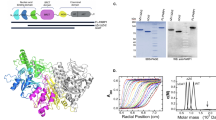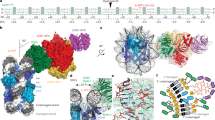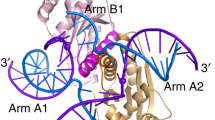Abstract
THE bZIP DNA-binding proteins are characterized by a 50-amino-acid DNA binding and dimerization motif, consisting of a highly basic DNA-binding region ('b') followed by a leucine zipper dimerization region ('ZIP')1. The best characterized bZIP DNA-binding protein is GCN4, a yeast transcriptional activator2–6. GCN4 binds to a 9-base-pair two-fold-symmetric DNA site, 5'−A−4T−3G−2A−1C0T+1C+2A+3T+4−3' (refs 7–10). A detailed model known as the 'induced helical fork' model has been proposed for the structure of the GCN4–DNA complex4. Using a site-specific bromouracil-mediated photocrosslinking method, we show here that the alanine at position 238 of GCN4 contacts, or is close to, the thymine 5-methyl of A·T at position +3 of the DNA site in the GCN4–DNA complex. Our results strongly support the induced helical fork model4. Our site-specific bromouracil-mediated photocrosslinking method requires no prior information regarding the structure of the protein or the structure of the protein–DNA complex and should be generalizable to DNA-binding proteins that interact with the DNA major groove11,12
This is a preview of subscription content, access via your institution
Access options
Subscribe to this journal
Receive 51 print issues and online access
$199.00 per year
only $3.90 per issue
Buy this article
- Purchase on Springer Link
- Instant access to full article PDF
Prices may be subject to local taxes which are calculated during checkout
Similar content being viewed by others
References
Vinson, C., Sigler, P. & McKnight, S. Science 246, 911–916 (1989).
Struhl, K. in Transcriptional Regulation (eds Yamamoto, K. & McKnight, S.) (Cold Spring Harbor Laboratory Press, New York, in the press).
Talanian, R., McKnight, C. J. & Kim, P. Science 249, 769–771 (1990).
O'Neil, K., Hoess, R. & DeGrado, W. Science 249, 774–778 (1990).
O'Shea, E., Klemm, J., Kim, P. & Alber, T. Science 254, 539–544 (1991).
Saudek, V. et al. Biochemistry 30, 1310–1317 (1991).
Hill, D., Hope, I., Macke, J. & Struhl, K. Science 234, 451–457 (1986).
Oliphant, A., Brandl, C. & Struhl, K. Molec. cell. Biol. 9, 2944–2949 (1989).
Mavrothalassitis, G., Beal, G. & Papas, T. DNA Cell Biol. 9, 783–788 (1990).
Gartenberg, M., Ampe, C., Steitz, T. & Crothers, D. Proc. natn. Acad. Sci. U.S.A. 87, 6034–6038 (1990).
Wick, K. & Matthews, K. J. biol. Chem. 266, 6106–6112 (1991).
Allen, T., Wick, K. & Matthews, K. J. biol. Chem. 266, 6113–6119 (1991).
Hutchinson, F. Q. Rev. Biophys. 6, 201–246 (1973).
Weiss, M. et al. Nature 347, 575–578 (1990).
Weiss, M. Biochemistry 29, 8020–8024 (1990).
Fried, M. & Crothers, D. Nucleic Acids Res. 9, 6505–6525 (1981).
Garner, M. & Revzin, A. Nucleic Acids Res. 9, 3047–3060 (1981).
Fisher, E. & Caruthers, M. Nucleic Acids Res. 7, 401–416 (1979).
Wharton, R. & Ptashne, M. Nature 326, 888–891 (1987).
Gunasekera, A., Ebright, Y. & Ebright, R. J. biol. Chem. 267, 14713–14720 (1992).
Pu, W. & Struhl, K. Nucleic Acids Res. 20, 771–775 (1992).
Goeddel, D., Yansura, D., Winston, C. & Caruthers, M. J. molec. Biol. 123, 661–687 (1978).
Brennan, C., van Cleve, M. & Gumport, R. J. biol. Chem. 261, 7270–7278 (1986).
Hayakawa, T., Ono, A. & Ueda, T. Nucleic Acids Res. 16, 4761–4776 (1988).
Fliess, A., Wolfes, H. & Pingould, A. Nucleic Acids Res. 16, 11781–11793 (1988).
Risse, G., Jooss, K., Neuberg, M., Brüller, H.-J. & Mu'ller, R. EMBO J 8, 3825–3832 (1989).
Lin, S.-Y. & Riggs, A. Proc. natn. Acad. Sci. U.S.A. 71, 947–951 (1974).
Ogata, R. & Gilbert, W. Proc. natn. Acad. Sci. U.S.A. 74, 4973–4976 (1977).
Simpson, R. Cell 18, 277–285 (1979).
Ebright, R., Ebright, Y. & Gunasekera, A. Nucleic Acids Res. 17, 10295–10305 (1989).
Author information
Authors and Affiliations
Rights and permissions
About this article
Cite this article
Blatter, E., Ebright, Y. & Ebright, R. Identification of an amino acid–base contact in the GCN4–DNA complex by bromouracil-mediated photocrosslinking. Nature 359, 650–652 (1992). https://doi.org/10.1038/359650a0
Received:
Accepted:
Issue Date:
DOI: https://doi.org/10.1038/359650a0
This article is cited by
Comments
By submitting a comment you agree to abide by our Terms and Community Guidelines. If you find something abusive or that does not comply with our terms or guidelines please flag it as inappropriate.



